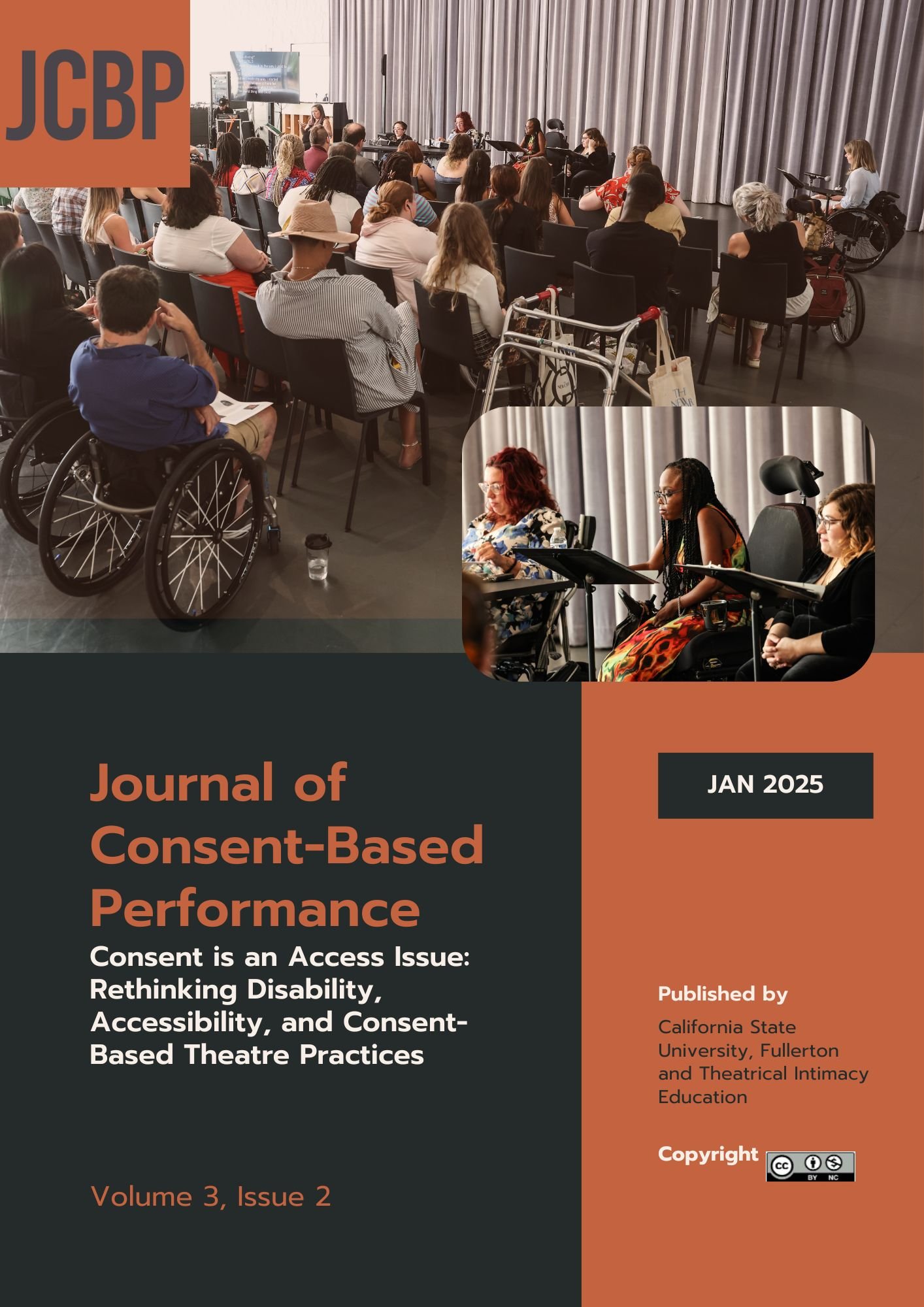
-
Consent is an Access Issue: Rethinking Disability, Accessibility, and Consent-Based Theatre Practices
Cover, Front Matter, and CFP
Table of Contents
Time is Money, and Consent is an Access Issue: Editor’s Comments
by Amanda Rose Villarreal, PhD
-
Cripping Consent: A Note from the Guest Editor
“The advances of recent years, while real and significant, are just the beginning of the ways the industry needs to adapt in order to achieve disability justice”
Read this Editorial by Catherine Peckinpaugh Vrtis, PhD
-
Disability Justice: Case Studies from a Disabled Intimacy Coordinator
This Note from the Field by Kaitlin Kerr highlights the creation of audio dramas and the ways in which intimacy direction applies to this unique and accessible form, as well as conversations arising out of the common experience of non-disabled actors playing disabled roles.
-
Interweaving Accessibility into Theatre: Working with Disabled Creatives for Disabled Audiences as a Disabled Theatre Maker
This Note from the Field by Grace Thomas explores how accessibility and consent-based practices were built into the research, development, and performance of a production about Fibromyalgia.
-
Crowdsourcing Content Guidance: A Commons-Based Approach to Harm Reduction in Theatre
This Note from the Field by Sabrina Zanello Jackson examines the process and product of a living, crowdsourced repository for playscript content warnings created by and for use by the theatre community. .
-
Sensing Dance: Finding Access Intimacy with a Dysmorphic Bodymind
This article, by Krista K. Miranda, discusses returning to dance during the onset of COVID-19 to explore how dancing while quarantined can help us imagine practices in line with what Mia Mingus calls “access intimacy” (2017) specifically for people with eating disorders and body dysmorphia. This article argues that turning to the works and access practices of Esteban, Healey, Shaw, and Washburn as models can transform the way dance practitioners engage with dance as both an aesthetic and a pedagogical practice, thereby making it more accessible for chronically ill bodyminds that are often neglected when we think of access.
-
Queer, Neurodivergent Access Intimacy: Conversations with Katya Vrtis and the Cast of JC Pankratz's Seahorse
This article, written by Nicolas Shannon Savard, uses director Nicolas Shannon Savard's experimental approach to ensemble-based audio description in a 2023 production of JC Pankratz's Seahorse as the starting point for investigating where intimacy direction, disability aesthetics, and queer storytelling overlap. Reflections from both the director and actors involved in the production aim to model possibilities for how consent-based, trauma-informed practices can foster access intimacy in the rehearsal room and open up additional pathways to nuanced, fully human portrayals of queerness, neurodivergence, and madness on stage. The case study is framed by a discussion with disability and performance scholar Katya Vrtis, exploring the broader implications of access intimacy as an approach to creating more human-centered artistic and academic spaces.
-
Micro-Events: A Potential Tool for Navigating Consent and Accessibility in Immersive Theatre
This article, by Melissa Bondar, analyzes how performers navigate moments of interaction in unexpected ways, building on Jorge Lopes Ramos’ (2015) concept of micro-events to expand how immersive performers can meet the needs of diverse audiences, fostering inclusivity while maintaining artistic integrity.
-
Consent of Creation
This article, by Regan Linton, examines a new work and its development process while highlighting the current state of accessibility in US theatre. The longstanding underrepresentation – or widespread exclusion – of artists with disabilities in theatre has led to general theatre practices that do not account for disabled voices, their complex intimacies in narrative and process, and offer little consent to the creation of the works that depict and involve the disability community. Using examples from a new play created with intentionality around consent of creation for its disabled artists, the author outlines ideas and principles that can foster new theatre paradigms that posit disability as an element of expansion in our collective experiences of intimacy and consent.